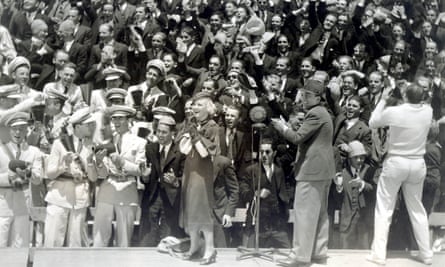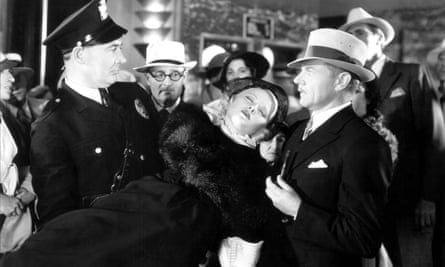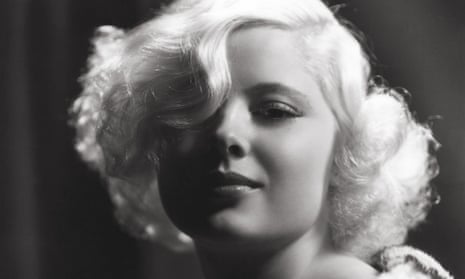In 1934, the Production Code Administration (PCA) was established to enforce film industry guidelines on morality (popularly known as the “Hays code”), and to set a seal of approval on every print of a Hollywood film. Mary Carlisle, who has died aged 104, had already kicked off her acting career with a score of pre-code movies in which the female characters were broadly divided into vamps, wives and virgins. As the roles played by the blond, doll-faced Carlisle fell into the third category, the code hardly affected her performances, as it did those of Mae West and even the cartoon character Betty Boop.
Although Carlisle could play the flirt, her characters lacked sexual allure, something that was intentional, and often pointed out on screen. In Should Ladies Behave (1933), her boyfriend says that he can’t marry her until she gains experience. “You’re too young, too crude; you’re collegiate and you can’t even smoke properly.”
Carlisle was often the ingenue among decadent socialites in films with titles such as Champagne for Breakfast (1934) and Lady Be Careful (1936) made by Poverty Row studios. She also cropped up as a student in convoluted campus comedies including The Sweetheart of Sigma Chi (1933), Girl o’ My Dreams (1934), That Navy Spirit (1937) and Touchdown, Army (1938), in which student sports heroes vied for her favours.
College Humor (1933) was the first of three screwball musical comedies in which she was cast opposite Bing Crosby as the swooning target of his sonorous crooning; Double or Nothing (1937) and Doctor Rhythm (1938) came later.
Carlisle was born Gwendolyn Witter in Boston, Massachusetts, to Leona (nee Wotton) and Arthur Witter. She was educated in a convent in Back Bay, Boston, but moved to Los Angeles with her mother some time after her father’s death when she was four years old. A few years later, her uncle Robert Carlisle, a film editor and producer, got her a chance to appear in one shot in the Jackie Coogan silent movie Long Live the King (1923).

When she was 14, Carlisle was discovered by the studio executive Carl Laemmle Jr, while eating lunch with her mother at the Universal Studios canteen. Struck by her “angelic looks”, according to publicity material, Laemmle offered her a screen test. But having passed the test, she was stopped by a welfare officer on the Universal lot who noticed that she was underage and should be at school.
After completing her education, she signed a one-year contract with MGM in 1930, appearing that year in prestigious movies such as Cecil B DeMille’s Madam Satan (attending a weird masquerade ball as Little Bo Peep) and Passion Flower, and in 1932 in Grand Hotel, in which she played a newly married guest. But she got her break at Paramount, especially with the Crosby movies.
However, the majority of her leading roles came in B movies – she played damsels in distress in Murder in the Private Car, The Great Hotel Murder and One Frightened Night. One of her rare appearances in an A movie was as the shy and quiet member of the dance troupe in Dorothy Arzner’s feminist drama Dance, Girl, Dance (1940), which starred Lucille Ball and Maureen O’Hara.

In 1942, Carlisle married the British actor James Blakeley, who later became an executive producer at 20th Century Fox. She decided to retire soon afterwards, having commented: “I’ve played sweet young heroines long enough.” Her last film was the low-budget (it was shot in six days) but effective vampire movie Dead Men Walk (1943) in which she played Gayle Clayton, the passive victim of her blood-sucking uncle (George Zucco).
Her show business life behind her, Carlisle became manager of the Elizabeth Arden beauty salon in Beverly Hills, California.
Her husband died in 2007. She is survived by their son, James.

Comments (…)
Sign in or create your Guardian account to join the discussion